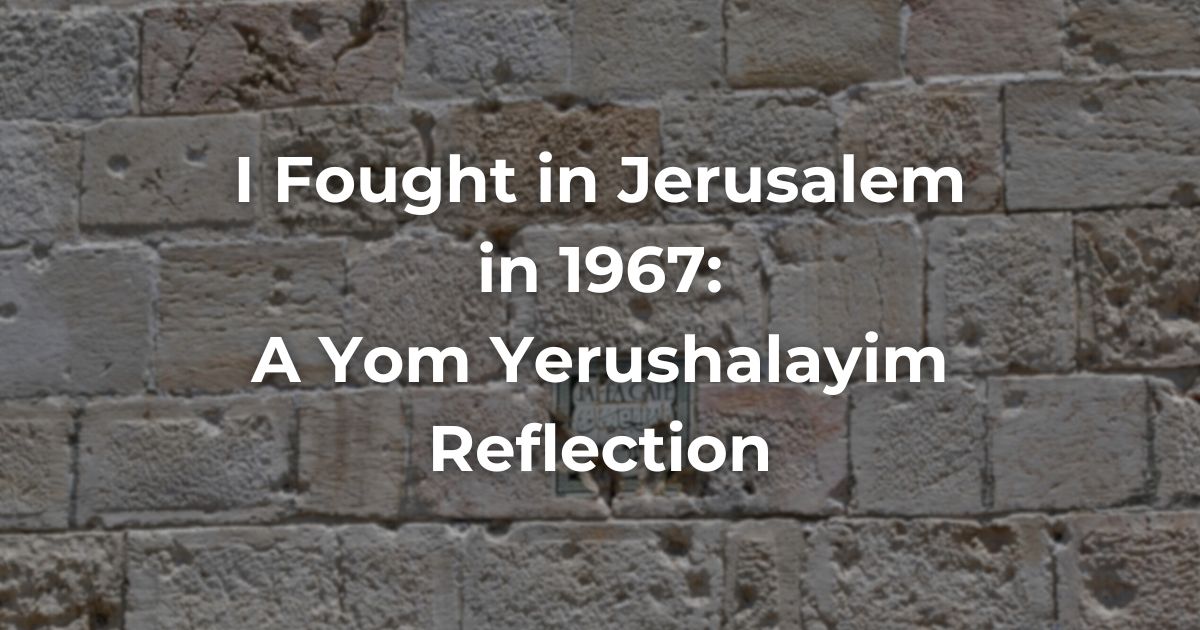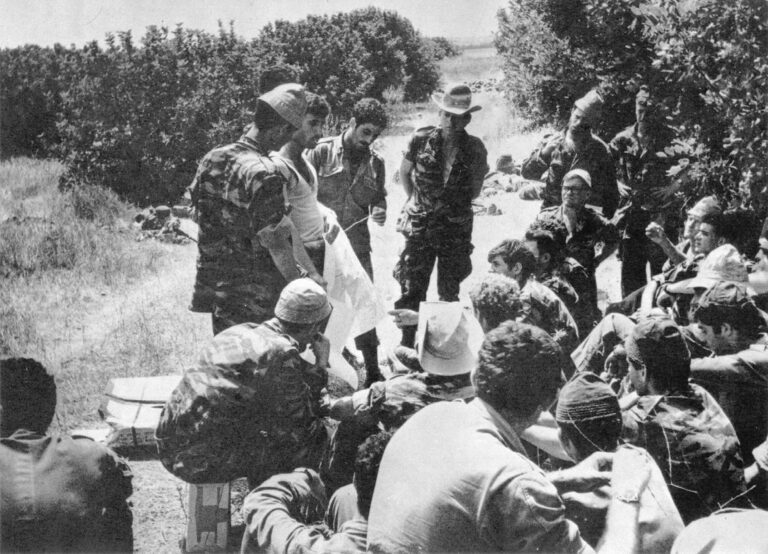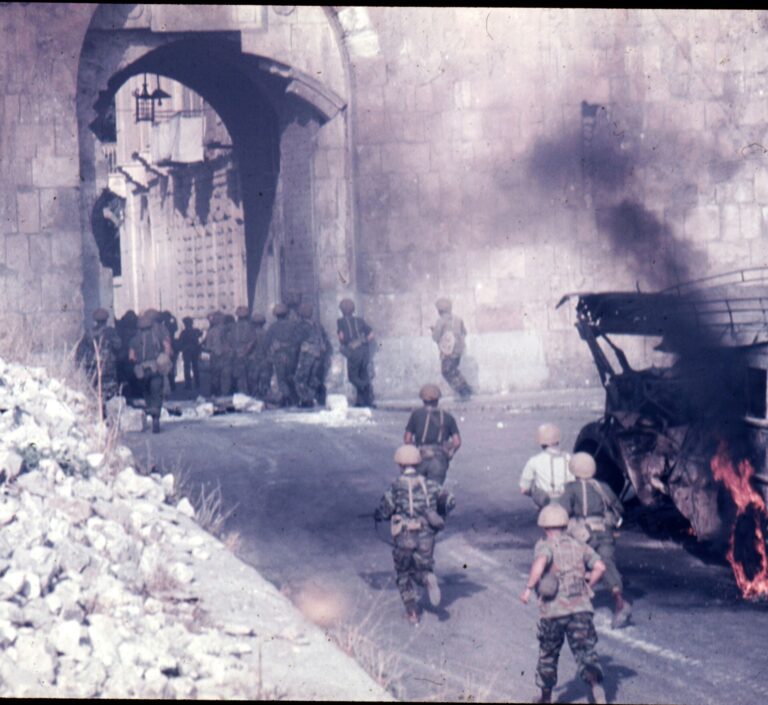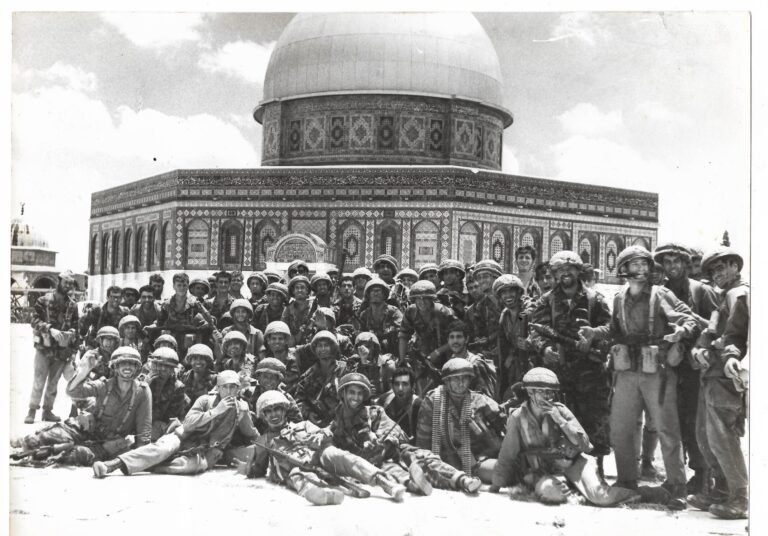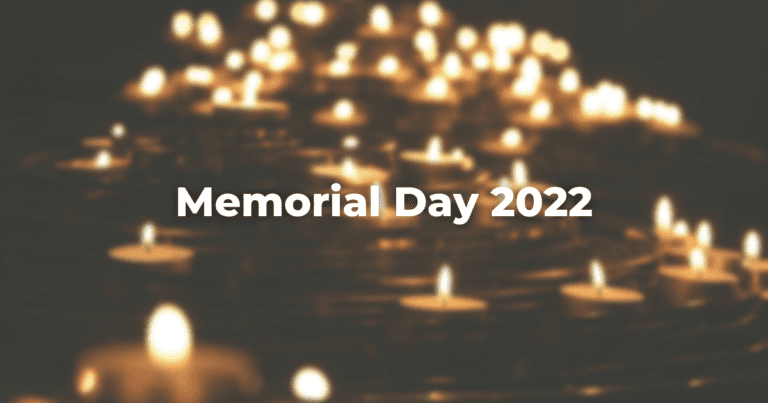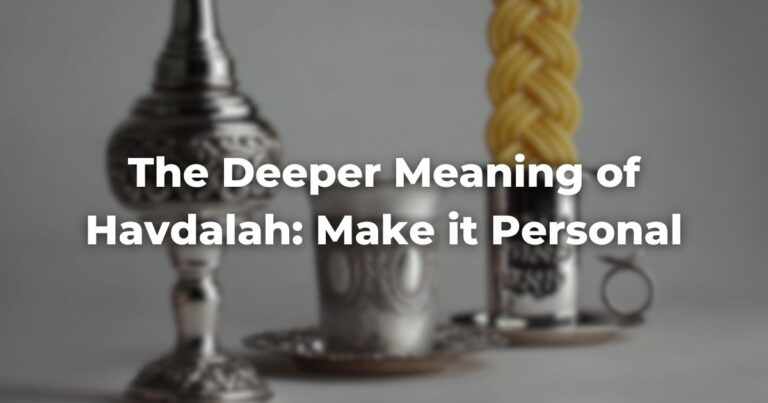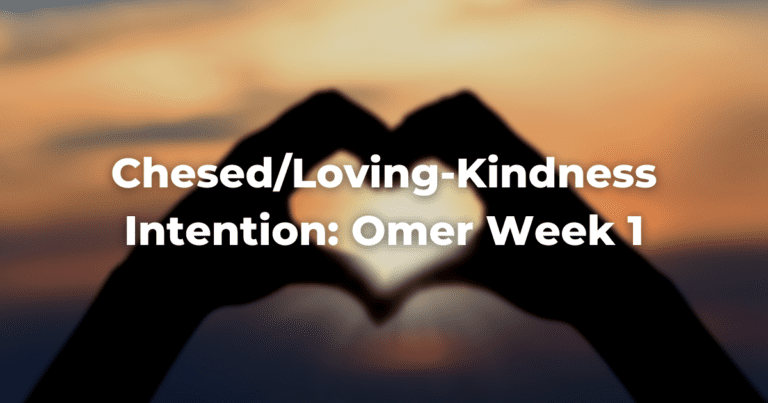Piece originially in Hebrew and translated by the Author.
Unforgettable moments! Fifty-seven years have passed since my company fought in the streets and allies of Jerusalem, yet I remember it as if it happened yesterday.
רגעים בלתי נשכחים! 57 שנים חלפו מאז לחמתי בסמטאות ירושלים כחייל בגדוד 71, אני משחזר רגעים אלה כאילו התרחשו אתמול…
On the third morning of the Six Day War, the compensation for climbing up a steep slope of the Mount of Olives was an order to turn around and walk back down, not in the open field, but rather on a paved street. After we reached the bottom of the valley, the street made a turn up and to the left, toward the intersection of the Rockefeller Museum and the north-eastern corner of the wall around the Old City.
Now I was feeling the weight of the three metal boxes, each containing 250 rounds of ammunition, which I was carrying on my back. It was almost noon on a hot day of June. I was in good physical shape, but felt like an overloaded mule rather than a light, swift paratrooper… What will I do when enemy snipers start firing at us? Would I be fast enough to run to shelter?
I slowed down and another soldier passed me. Then a different thought struck my mind: The last time a Jewish soldier climbed up this slope was 19 centuries ago, in the Revolt against the Roman Empire. If I lagged behind, I would not forgive myself for the next 19 centuries! Somehow, I got a second wind and caught up…
בבוקר היום השלישי למלחמת ששת הימים, אחרי שטיפסנו במדרון הר הזיתים למחנה הלגיון הסמוך ל’אוגוסטה ויקטוריה’, הסתובבנו וירדנו על כביש אספלט לעמק נחל קדרון, ומשם במעלה הכביש אל הצומת בין מוזיאון רוקפלר לפינה הצפונית-מזרחית של חומת העיר העתיקה.
שמש קיץ העפילה למרום השמים, והתחלתי להרגיש את כובד שלושת ‘ארגזי הפעולה’ הדחוסים שרשרות כדורים על גבי… מה יהיה אם אצטרך לרוץ במהירות לתפוס מחסה?
אני מרגיש כמו פרד עמוס ולא כחייל קרבי! המחשבות האטו את הליכתי בטור העורפי, ושני חיילים שצעדו אחריי עקפו אותי… ברגע זה, חלפה מחשבה בראשי: הפעם האחרונה שחייל יהודי חמוש טיפס במדרון הזה הייתה לפני 1900 שנה, במרד נגד הרומאים. אם אפגר עכשיו אחרי הפלוגה שלי, לא אסלח לעצמי גם בעוד 1900 שנה! רגליי נשאו אותי במהירות וחזרתי לצעוד אחרי מפקד המחלקה…
…fifteen minutes later we took a sharp turn to the right, climbing up the alley that leads to the Lions’ Gate. An Israeli tank that arrived from the opposite direction fired into the alley and hit an empty bus which was parked there. It was not a stupid thing to do! The smoke around the burning bus made the alley look very narrow.
כרבע שעה אחרי כן: פנייה חדה מערבה לתוך הסמטה העולה אל ‘שער האריות’. את תבליט האריות באבן משני צדי השער כיסה עשן שחור של אוטובוס בוער. האש והעשן כפו על שני הטורים בשני צידי הסמטה להתמזג לטור אחד.
We knew there could be several enemy snipers hiding behind the cracks in the ancient wall, but as long as we were behind the smoke of the burning bus we felt safer… Only in the last 100 yards between the bus and the Gate, we were running like crazy. Luckily, for no reason! There was no more shooting at this point, only a “traffic jam” of over 200 paratroopers, each trying to pass through the narrow gate as fast as possible.
Pushing and shouting disappeared as soon as we took the first turn to the left after the Lions’ Gate. After a few minutes of walking in silence, we could already see the Dome of the Rock atop the center of the Temple Mount in front of us. Suddenly some of us began singing the refrain of a new song which became popular overnight only three weeks before the war: Yerushalayim shel Zahav. Everybody joined the singing! We did not remember all the words, but at least we knew the chorus.
On the Temple Mount the mood switched from battle mode to celebration, as if we had not witnessed our friends being killed or wounded an hour earlier. We were singing and shouting, as if we were intoxicated with a unique joy: “We just made History! We now reunited the Temple Mount with our people, 19 centuries after being torn-apart!”
נוצר ‘פקק תנועה’ של חיילים בכניסה לשער האריות. כל שלושת גדודי החטיבה נהרו לאותו כיוון, וכולם רצו להקדים להיכנס לעיר העתיקה. להתרגשות של הפריצה לעיר שעברה קרבות קשים במשך שלושת-אלפי שנה, נוסף מתח, בגלל הסכנה שבצפיפות תחת שער האבן פגז מרגמה או רימון יד עלול היה לחסל תריסר חיילים בבת אחת…
הצעקות והדחיפות נסתיימו ברגע שהטור פנה שמאלה לכיוון הר הבית. ידענו לאן פנינו מועדות. כשראינו מולנו את ‘כיפת הסלע’, התחלנו לשיר בהתלהבות את פזמון השיר ‘ירושלים של זהב’ – השיר שזינק לראש התודעה הלאומית שלושה שבועות לפני פרוץ המלחמה.
במטה קסם, נעלם האדרנלין של אינסטינקט ההישרדות: מלאך המוות שעד לפני זמן קצר טייל בחרמשו בין גדודי החטיבה, נעלם אחרי שנכנסנו דרך שער האריות, ועכשיו התמסרנו לתחושה הנפלאה: עשינו היסטוריה! הר הבית בידינו!
Every year on Jerusalem Day (28th Iyar) I join the veterans of Battalion 71 at the site of the stone Memorial commemorating our friends who fell in battle. The memorial was built in the western section of Sheikh Jarakh. In recent years there is a diminishing attendance, not only because those who served with me in the Six Day War (June 67) are approaching the “age of Gvurot” (80 and up), but also because some of us were disgusted by the sight of the March of the Flags –a crowd of Israeli Jews (many of them Orthodox) carrying Israeli Flags and shouting racist slogans against Arabs and Moslems (e.g., “Muhammad is dead!”).
You may call me naïve but I still envision Jerusalem as a city where people of all religions, nationalities and races will dwell together in peaceful coexistence. Shalem was the original Biblical name of Jerusalem, a name that signifies a vision of Integrity and Peace.
בכל שנה ביום ירושלים (כח באייר) אנו נפגשים, ותיקי גדוד 71, באנדרטה הגדודית, במערב שכונת שיח-ג’ראח. בשנים האחרונות יש פחות ופחות משתתפים, לא רק בגלל שכולנו קרובים ל’גבורות’, אלא גם בגלל המחזה המביש של ‘מצעד הדגלים’: הפגנת כח של קנאים-גזעניים הנושאים את דגל ישראל ומבזים אותו בקריאות נאצה כלפי התושבים הערבים בירושלים.
אתם רשאים לקרוא לי ‘נאיבי’ אבל אני עדיין מאמין בחזון שירושלים תהיה עיר המחברת יחדיו לא רק את הפלגים והזרמים בתוך עם ישראל, אלא גם את תושביה בני כל העמים, הדתות וההשקפות.
Author
-
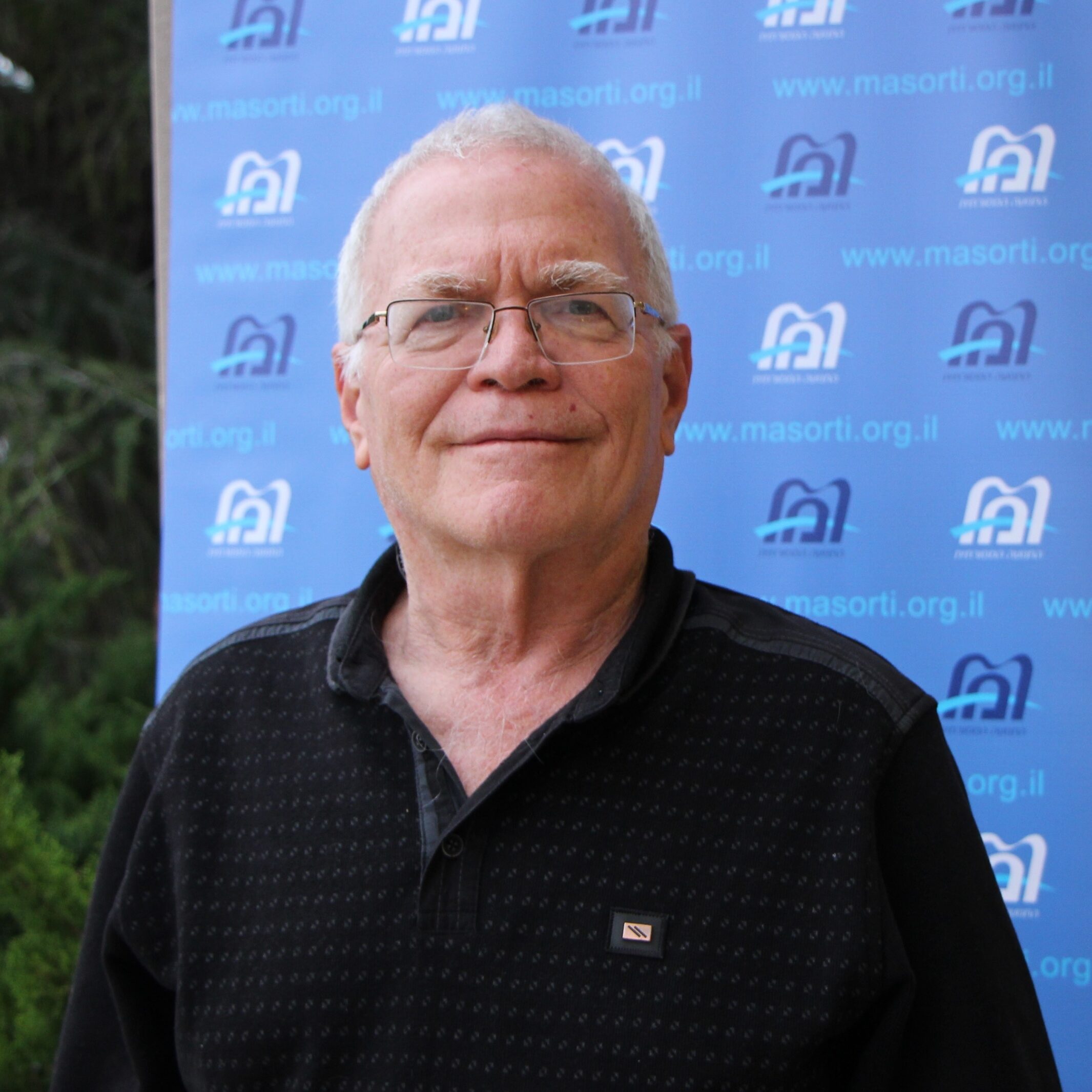
Third generation Israeli. 1967- paratrooper in the Six Day War. 1970-1972 Youth-leader, Or-Chadash, Haifa. 1972-1974 Hebrew Teacher and Youth-advisor, Knesset Israel, Gloversville, NY. 1974-1979 M.A. Judaic Studies, Hebrew University. Rabbinic School, Hebrew Union College, Jerusalem.
View all posts
1979-1985 Rabbi and TalmudReferring to one of two collections, the Jerusalem and Babylonian Talmuds, edited in the 6th century, that contains hundreds of years of commentary, discussion, and exploration of the ideas in the Mishnah. One could describe it as Mishnah + Gemara = Talmud Read more teacher, Leo Baeck Education Centre, Haifa.
1985-1990 Ph.D. H.U.C. Cincinnati, Ohio. 1992-2002 Rabbi, Moriah, Haifa. 1996-1998 President of Israeli R.A. 1998-2002 Talmud Lecturer, Haifa U. 2002/3 Talmud Lecturer, L.A. 2003/4 Talmud Lecturer, London. 2004-2012 rabbi, Magen Avraham, Omer. 2012-2015 Rabbi, Beit Warszawa, Warsaw, Poland. Since 2015 Rabbi, Hakerem, Karmiel. April 2016–April 2023 Co-chair of Va'ad HaHalakha, the Israeli R.A.
Married to Zivah, 3 Children, 7 grandchildren. Hobbies: A daily page of Talmud and Israeli folk dancing.

